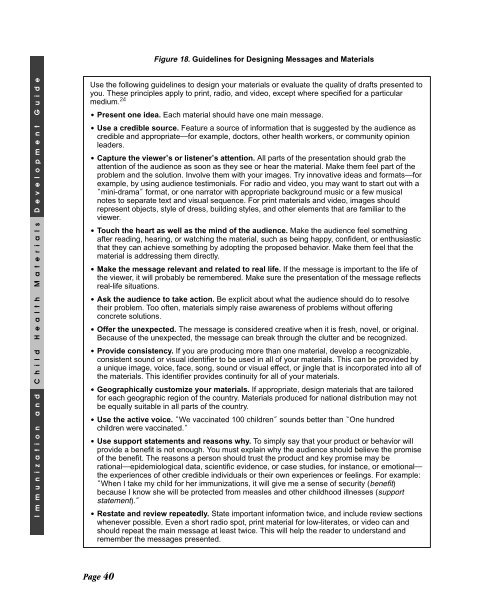Immunization and child health materials development guide pdf
Immunization and child health materials development guide pdf
Immunization and child health materials development guide pdf
You also want an ePaper? Increase the reach of your titles
YUMPU automatically turns print PDFs into web optimized ePapers that Google loves.
Figure 18. Guidelines for Designing Messages <strong>and</strong> Materials<br />
Use the following <strong>guide</strong>lines to design your <strong>materials</strong> or evaluate the quality of drafts presented to<br />
you. These principles apply to print, radio, <strong>and</strong> video, except where specified for a particular<br />
medium. 24<br />
• Present one idea. Each material should have one main message.<br />
• Use a credible source. Feature a source of information that is suggested by the audience as<br />
credible <strong>and</strong> appropriate—for example, doctors, other <strong>health</strong> workers, or community opinion<br />
leaders.<br />
• Capture the viewer’s or listener’s attention. All parts of the presentation should grab the<br />
attention of the audience as soon as they see or hear the material. Make them feel part of the<br />
problem <strong>and</strong> the solution. Involve them with your images. Try innovative ideas <strong>and</strong> formats—for<br />
example, by using audience testimonials. For radio <strong>and</strong> video, you may want to start out with a<br />
“mini-drama” format, or one narrator with appropriate background music or a few musical<br />
notes to separate text <strong>and</strong> visual sequence. For print <strong>materials</strong> <strong>and</strong> video, images should<br />
represent objects, style of dress, building styles, <strong>and</strong> other elements that are familiar to the<br />
viewer.<br />
• Touch the heart as well as the mind of the audience. Make the audience feel something<br />
after reading, hearing, or watching the material, such as being happy, confident, or enthusiastic<br />
that they can achieve something by adopting the proposed behavior. Make them feel that the<br />
material is addressing them directly.<br />
• Make the message relevant <strong>and</strong> related to real life. If the message is important to the life of<br />
the viewer, it will probably be remembered. Make sure the presentation of the message reflects<br />
real-life situations.<br />
• Ask the audience to take action. Be explicit about what the audience should do to resolve<br />
their problem. Too often, <strong>materials</strong> simply raise awareness of problems without offering<br />
concrete solutions.<br />
• Offer the unexpected. The message is considered creative when it is fresh, novel, or original.<br />
Because of the unexpected, the message can break through the clutter <strong>and</strong> be recognized.<br />
• Provide consistency. If you are producing more than one material, develop a recognizable,<br />
consistent sound or visual identifier to be used in all of your <strong>materials</strong>. This can be provided by<br />
a unique image, voice, face, song, sound or visual effect, or jingle that is incorporated into all of<br />
the <strong>materials</strong>. This identifier provides continuity for all of your <strong>materials</strong>.<br />
• Geographically customize your <strong>materials</strong>. If appropriate, design <strong>materials</strong> that are tailored<br />
for each geographic region of the country. Materials produced for national distribution may not<br />
be equally suitable in all parts of the country.<br />
• Use the active voice. “We vaccinated 100 <strong>child</strong>ren” sounds better than “One hundred<br />
<strong>child</strong>ren were vaccinated.”<br />
• Use support statements <strong>and</strong> reasons why. To simply say that your product or behavior will<br />
provide a benefit is not enough. You must explain why the audience should believe the promise<br />
of the benefit. The reasons a person should trust the product <strong>and</strong> key promise may be<br />
rational—epidemiological data, scientific evidence, or case studies, for instance, or emotional—<br />
the experiences of other credible individuals or their own experiences or feelings. For example:<br />
“When I take my <strong>child</strong> for her immunizations, it will give me a sense of security (benefit)<br />
because I know she will be protected from measles <strong>and</strong> other <strong>child</strong>hood illnesses (support<br />
statement).”<br />
• Restate <strong>and</strong> review repeatedly. State important information twice, <strong>and</strong> include review sections<br />
whenever possible. Even a short radio spot, print material for low-literates, or video can <strong>and</strong><br />
should repeat the main message at least twice. This will help the reader to underst<strong>and</strong> <strong>and</strong><br />
remember the messages presented.<br />
Page 40

















